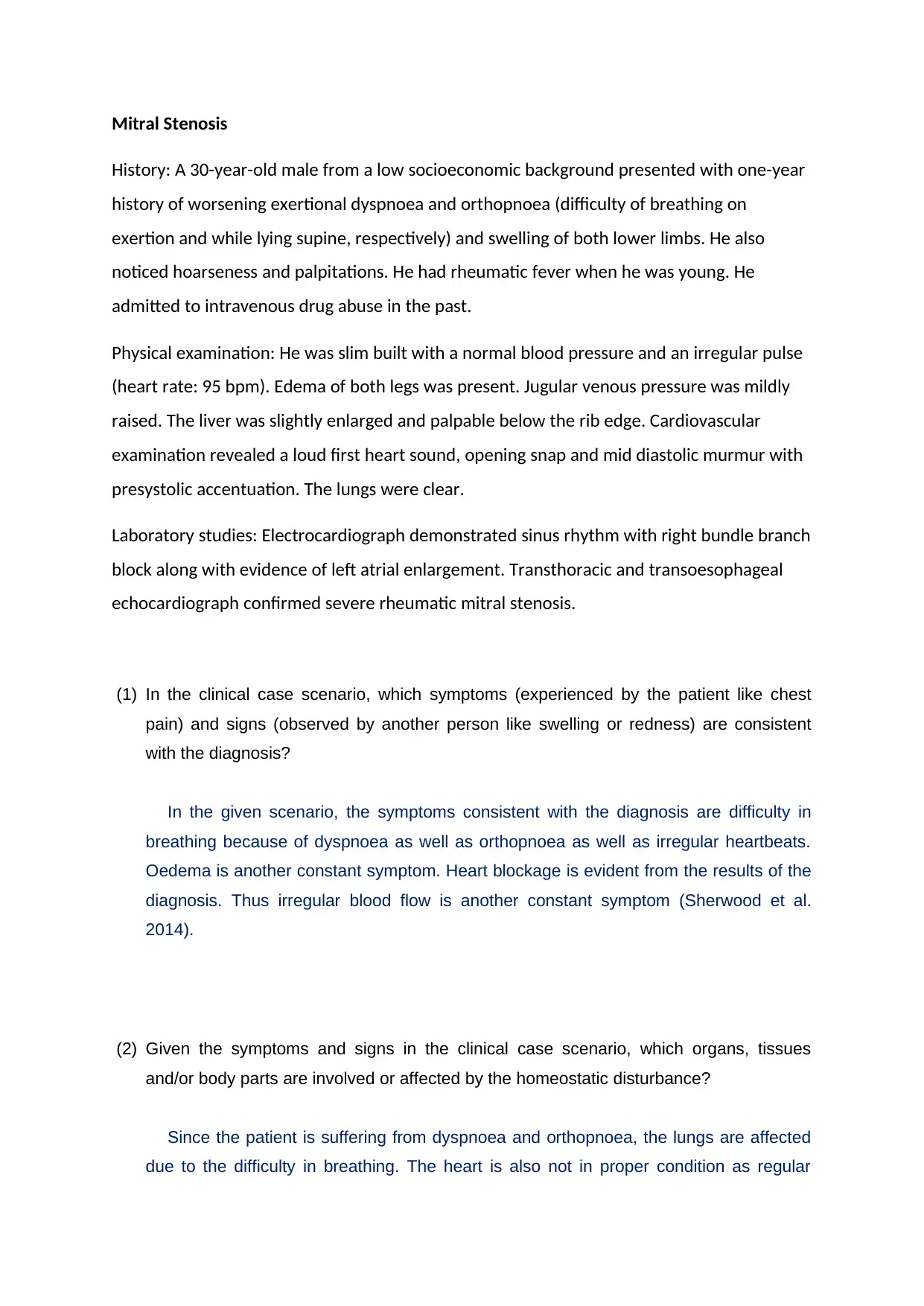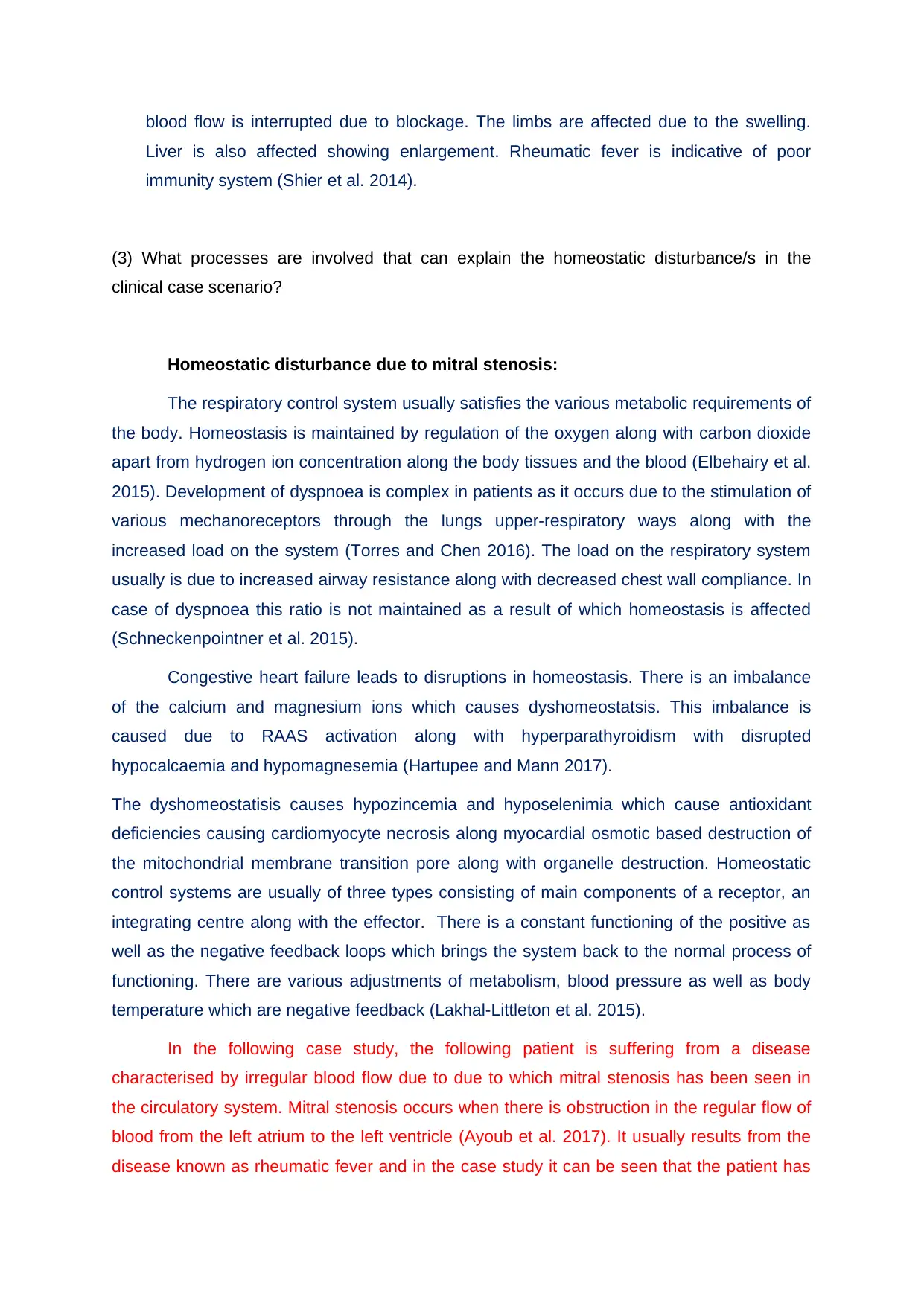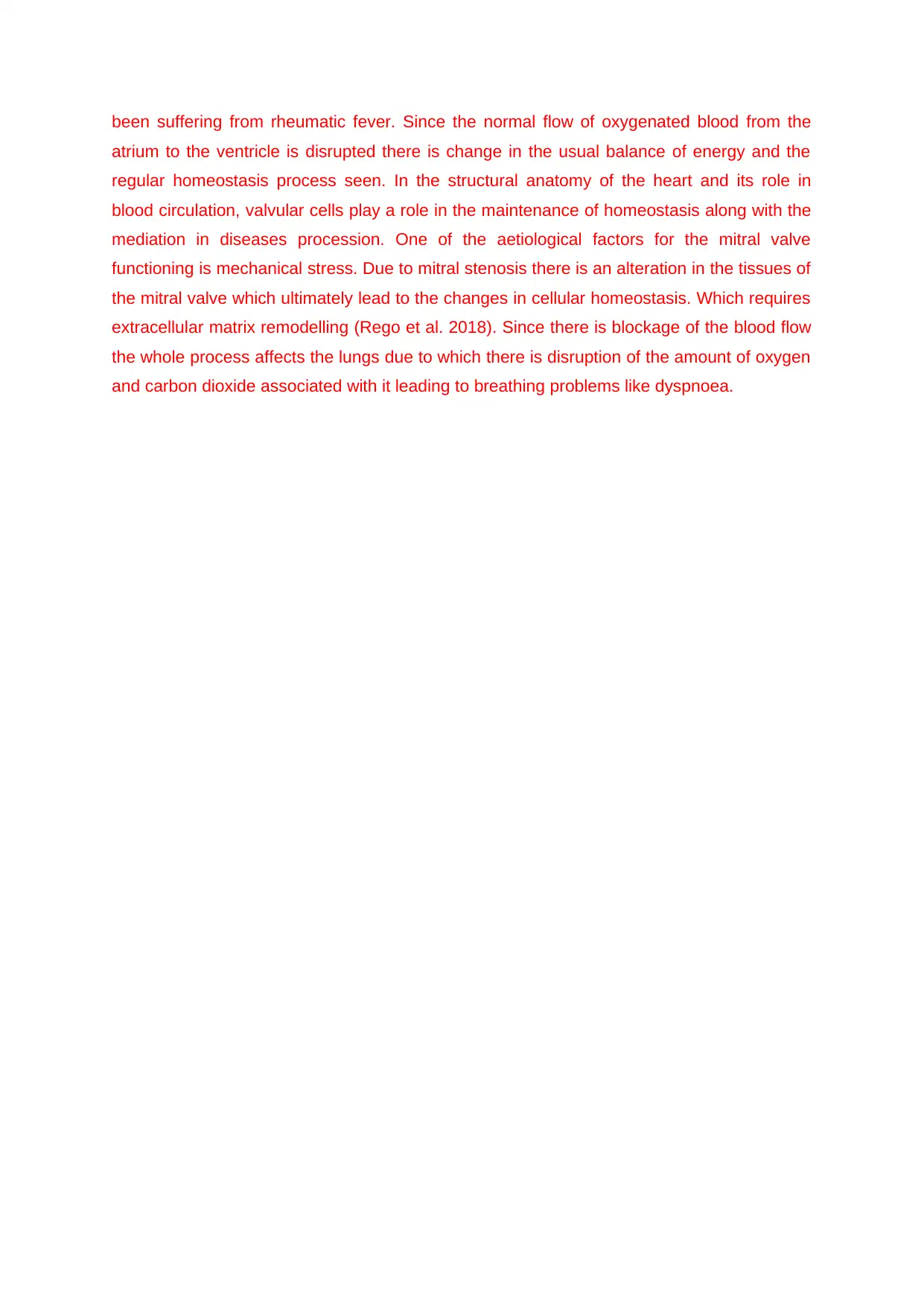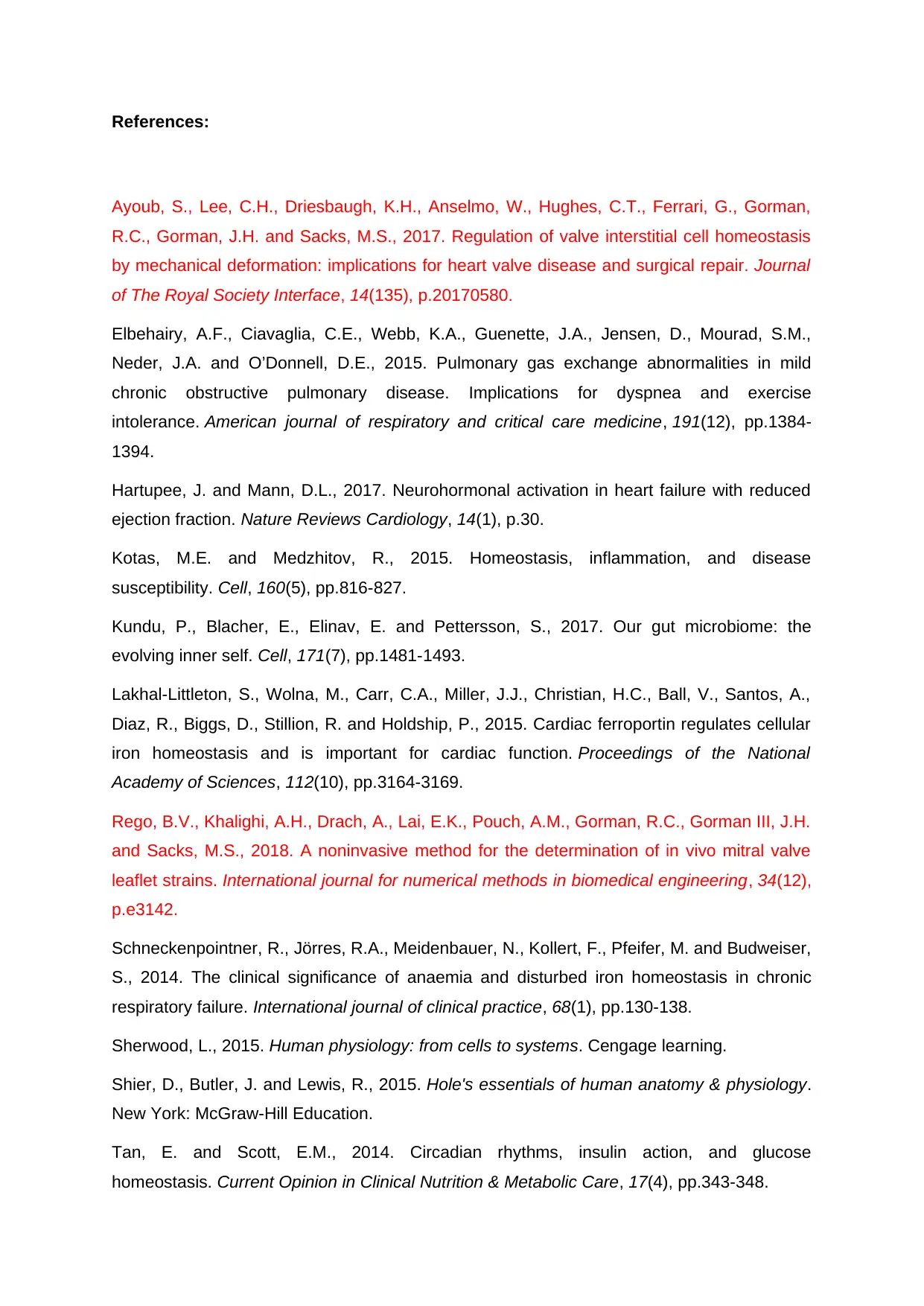Mitral Stenosis: A Case Study Analysis of Symptoms and Signs
VerifiedAdded on 2023/04/04
|5
|1166
|83
Case Study
AI Summary
This case study presents a 30-year-old male with mitral stenosis, detailing his symptoms of exertional dyspnoea, orthopnoea, lower limb swelling, hoarseness, and palpitations, along with a history of rheumatic fever and intravenous drug abuse. Physical examination revealed edema, raised jugular venous pressure, and an enlarged liver. Cardiovascular examination showed a loud first heart sound, opening snap, and mid-diastolic murmur. The analysis identifies symptoms like dyspnoea, orthopnoea, irregular heartbeats, and oedema as consistent with the diagnosis. The case study further explores the involvement of organs such as the lungs, heart, and liver in the homeostatic disturbance, attributing the issues to disrupted respiratory control, calcium/magnesium imbalances, and impaired blood flow due to mitral stenosis and referencing the role of valvular cells in maintaining homeostasis.

Mitral Stenosis
History: A 30-year-old male from a low socioeconomic background presented with one-year
history of worsening exertional dyspnoea and orthopnoea (difficulty of breathing on
exertion and while lying supine, respectively) and swelling of both lower limbs. He also
noticed hoarseness and palpitations. He had rheumatic fever when he was young. He
admitted to intravenous drug abuse in the past.
Physical examination: He was slim built with a normal blood pressure and an irregular pulse
(heart rate: 95 bpm). Edema of both legs was present. Jugular venous pressure was mildly
raised. The liver was slightly enlarged and palpable below the rib edge. Cardiovascular
examination revealed a loud first heart sound, opening snap and mid diastolic murmur with
presystolic accentuation. The lungs were clear.
Laboratory studies: Electrocardiograph demonstrated sinus rhythm with right bundle branch
block along with evidence of left atrial enlargement. Transthoracic and transoesophageal
echocardiograph confirmed severe rheumatic mitral stenosis.
(1) In the clinical case scenario, which symptoms (experienced by the patient like chest
pain) and signs (observed by another person like swelling or redness) are consistent
with the diagnosis?
In the given scenario, the symptoms consistent with the diagnosis are difficulty in
breathing because of dyspnoea as well as orthopnoea as well as irregular heartbeats.
Oedema is another constant symptom. Heart blockage is evident from the results of the
diagnosis. Thus irregular blood flow is another constant symptom (Sherwood et al.
2014).
(2) Given the symptoms and signs in the clinical case scenario, which organs, tissues
and/or body parts are involved or affected by the homeostatic disturbance?
Since the patient is suffering from dyspnoea and orthopnoea, the lungs are affected
due to the difficulty in breathing. The heart is also not in proper condition as regular
History: A 30-year-old male from a low socioeconomic background presented with one-year
history of worsening exertional dyspnoea and orthopnoea (difficulty of breathing on
exertion and while lying supine, respectively) and swelling of both lower limbs. He also
noticed hoarseness and palpitations. He had rheumatic fever when he was young. He
admitted to intravenous drug abuse in the past.
Physical examination: He was slim built with a normal blood pressure and an irregular pulse
(heart rate: 95 bpm). Edema of both legs was present. Jugular venous pressure was mildly
raised. The liver was slightly enlarged and palpable below the rib edge. Cardiovascular
examination revealed a loud first heart sound, opening snap and mid diastolic murmur with
presystolic accentuation. The lungs were clear.
Laboratory studies: Electrocardiograph demonstrated sinus rhythm with right bundle branch
block along with evidence of left atrial enlargement. Transthoracic and transoesophageal
echocardiograph confirmed severe rheumatic mitral stenosis.
(1) In the clinical case scenario, which symptoms (experienced by the patient like chest
pain) and signs (observed by another person like swelling or redness) are consistent
with the diagnosis?
In the given scenario, the symptoms consistent with the diagnosis are difficulty in
breathing because of dyspnoea as well as orthopnoea as well as irregular heartbeats.
Oedema is another constant symptom. Heart blockage is evident from the results of the
diagnosis. Thus irregular blood flow is another constant symptom (Sherwood et al.
2014).
(2) Given the symptoms and signs in the clinical case scenario, which organs, tissues
and/or body parts are involved or affected by the homeostatic disturbance?
Since the patient is suffering from dyspnoea and orthopnoea, the lungs are affected
due to the difficulty in breathing. The heart is also not in proper condition as regular
Paraphrase This Document
Need a fresh take? Get an instant paraphrase of this document with our AI Paraphraser

blood flow is interrupted due to blockage. The limbs are affected due to the swelling.
Liver is also affected showing enlargement. Rheumatic fever is indicative of poor
immunity system (Shier et al. 2014).
(3) What processes are involved that can explain the homeostatic disturbance/s in the
clinical case scenario?
Homeostatic disturbance due to mitral stenosis:
The respiratory control system usually satisfies the various metabolic requirements of
the body. Homeostasis is maintained by regulation of the oxygen along with carbon dioxide
apart from hydrogen ion concentration along the body tissues and the blood (Elbehairy et al.
2015). Development of dyspnoea is complex in patients as it occurs due to the stimulation of
various mechanoreceptors through the lungs upper-respiratory ways along with the
increased load on the system (Torres and Chen 2016). The load on the respiratory system
usually is due to increased airway resistance along with decreased chest wall compliance. In
case of dyspnoea this ratio is not maintained as a result of which homeostasis is affected
(Schneckenpointner et al. 2015).
Congestive heart failure leads to disruptions in homeostasis. There is an imbalance
of the calcium and magnesium ions which causes dyshomeostatsis. This imbalance is
caused due to RAAS activation along with hyperparathyroidism with disrupted
hypocalcaemia and hypomagnesemia (Hartupee and Mann 2017).
The dyshomeostatisis causes hypozincemia and hyposelenimia which cause antioxidant
deficiencies causing cardiomyocyte necrosis along myocardial osmotic based destruction of
the mitochondrial membrane transition pore along with organelle destruction. Homeostatic
control systems are usually of three types consisting of main components of a receptor, an
integrating centre along with the effector. There is a constant functioning of the positive as
well as the negative feedback loops which brings the system back to the normal process of
functioning. There are various adjustments of metabolism, blood pressure as well as body
temperature which are negative feedback (Lakhal-Littleton et al. 2015).
In the following case study, the following patient is suffering from a disease
characterised by irregular blood flow due to due to which mitral stenosis has been seen in
the circulatory system. Mitral stenosis occurs when there is obstruction in the regular flow of
blood from the left atrium to the left ventricle (Ayoub et al. 2017). It usually results from the
disease known as rheumatic fever and in the case study it can be seen that the patient has
Liver is also affected showing enlargement. Rheumatic fever is indicative of poor
immunity system (Shier et al. 2014).
(3) What processes are involved that can explain the homeostatic disturbance/s in the
clinical case scenario?
Homeostatic disturbance due to mitral stenosis:
The respiratory control system usually satisfies the various metabolic requirements of
the body. Homeostasis is maintained by regulation of the oxygen along with carbon dioxide
apart from hydrogen ion concentration along the body tissues and the blood (Elbehairy et al.
2015). Development of dyspnoea is complex in patients as it occurs due to the stimulation of
various mechanoreceptors through the lungs upper-respiratory ways along with the
increased load on the system (Torres and Chen 2016). The load on the respiratory system
usually is due to increased airway resistance along with decreased chest wall compliance. In
case of dyspnoea this ratio is not maintained as a result of which homeostasis is affected
(Schneckenpointner et al. 2015).
Congestive heart failure leads to disruptions in homeostasis. There is an imbalance
of the calcium and magnesium ions which causes dyshomeostatsis. This imbalance is
caused due to RAAS activation along with hyperparathyroidism with disrupted
hypocalcaemia and hypomagnesemia (Hartupee and Mann 2017).
The dyshomeostatisis causes hypozincemia and hyposelenimia which cause antioxidant
deficiencies causing cardiomyocyte necrosis along myocardial osmotic based destruction of
the mitochondrial membrane transition pore along with organelle destruction. Homeostatic
control systems are usually of three types consisting of main components of a receptor, an
integrating centre along with the effector. There is a constant functioning of the positive as
well as the negative feedback loops which brings the system back to the normal process of
functioning. There are various adjustments of metabolism, blood pressure as well as body
temperature which are negative feedback (Lakhal-Littleton et al. 2015).
In the following case study, the following patient is suffering from a disease
characterised by irregular blood flow due to due to which mitral stenosis has been seen in
the circulatory system. Mitral stenosis occurs when there is obstruction in the regular flow of
blood from the left atrium to the left ventricle (Ayoub et al. 2017). It usually results from the
disease known as rheumatic fever and in the case study it can be seen that the patient has

been suffering from rheumatic fever. Since the normal flow of oxygenated blood from the
atrium to the ventricle is disrupted there is change in the usual balance of energy and the
regular homeostasis process seen. In the structural anatomy of the heart and its role in
blood circulation, valvular cells play a role in the maintenance of homeostasis along with the
mediation in diseases procession. One of the aetiological factors for the mitral valve
functioning is mechanical stress. Due to mitral stenosis there is an alteration in the tissues of
the mitral valve which ultimately lead to the changes in cellular homeostasis. Which requires
extracellular matrix remodelling (Rego et al. 2018). Since there is blockage of the blood flow
the whole process affects the lungs due to which there is disruption of the amount of oxygen
and carbon dioxide associated with it leading to breathing problems like dyspnoea.
atrium to the ventricle is disrupted there is change in the usual balance of energy and the
regular homeostasis process seen. In the structural anatomy of the heart and its role in
blood circulation, valvular cells play a role in the maintenance of homeostasis along with the
mediation in diseases procession. One of the aetiological factors for the mitral valve
functioning is mechanical stress. Due to mitral stenosis there is an alteration in the tissues of
the mitral valve which ultimately lead to the changes in cellular homeostasis. Which requires
extracellular matrix remodelling (Rego et al. 2018). Since there is blockage of the blood flow
the whole process affects the lungs due to which there is disruption of the amount of oxygen
and carbon dioxide associated with it leading to breathing problems like dyspnoea.
⊘ This is a preview!⊘
Do you want full access?
Subscribe today to unlock all pages.

Trusted by 1+ million students worldwide

References:
Ayoub, S., Lee, C.H., Driesbaugh, K.H., Anselmo, W., Hughes, C.T., Ferrari, G., Gorman,
R.C., Gorman, J.H. and Sacks, M.S., 2017. Regulation of valve interstitial cell homeostasis
by mechanical deformation: implications for heart valve disease and surgical repair. Journal
of The Royal Society Interface, 14(135), p.20170580.
Elbehairy, A.F., Ciavaglia, C.E., Webb, K.A., Guenette, J.A., Jensen, D., Mourad, S.M.,
Neder, J.A. and O’Donnell, D.E., 2015. Pulmonary gas exchange abnormalities in mild
chronic obstructive pulmonary disease. Implications for dyspnea and exercise
intolerance. American journal of respiratory and critical care medicine, 191(12), pp.1384-
1394.
Hartupee, J. and Mann, D.L., 2017. Neurohormonal activation in heart failure with reduced
ejection fraction. Nature Reviews Cardiology, 14(1), p.30.
Kotas, M.E. and Medzhitov, R., 2015. Homeostasis, inflammation, and disease
susceptibility. Cell, 160(5), pp.816-827.
Kundu, P., Blacher, E., Elinav, E. and Pettersson, S., 2017. Our gut microbiome: the
evolving inner self. Cell, 171(7), pp.1481-1493.
Lakhal-Littleton, S., Wolna, M., Carr, C.A., Miller, J.J., Christian, H.C., Ball, V., Santos, A.,
Diaz, R., Biggs, D., Stillion, R. and Holdship, P., 2015. Cardiac ferroportin regulates cellular
iron homeostasis and is important for cardiac function. Proceedings of the National
Academy of Sciences, 112(10), pp.3164-3169.
Rego, B.V., Khalighi, A.H., Drach, A., Lai, E.K., Pouch, A.M., Gorman, R.C., Gorman III, J.H.
and Sacks, M.S., 2018. A noninvasive method for the determination of in vivo mitral valve
leaflet strains. International journal for numerical methods in biomedical engineering, 34(12),
p.e3142.
Schneckenpointner, R., Jörres, R.A., Meidenbauer, N., Kollert, F., Pfeifer, M. and Budweiser,
S., 2014. The clinical significance of anaemia and disturbed iron homeostasis in chronic
respiratory failure. International journal of clinical practice, 68(1), pp.130-138.
Sherwood, L., 2015. Human physiology: from cells to systems. Cengage learning.
Shier, D., Butler, J. and Lewis, R., 2015. Hole's essentials of human anatomy & physiology.
New York: McGraw-Hill Education.
Tan, E. and Scott, E.M., 2014. Circadian rhythms, insulin action, and glucose
homeostasis. Current Opinion in Clinical Nutrition & Metabolic Care, 17(4), pp.343-348.
Ayoub, S., Lee, C.H., Driesbaugh, K.H., Anselmo, W., Hughes, C.T., Ferrari, G., Gorman,
R.C., Gorman, J.H. and Sacks, M.S., 2017. Regulation of valve interstitial cell homeostasis
by mechanical deformation: implications for heart valve disease and surgical repair. Journal
of The Royal Society Interface, 14(135), p.20170580.
Elbehairy, A.F., Ciavaglia, C.E., Webb, K.A., Guenette, J.A., Jensen, D., Mourad, S.M.,
Neder, J.A. and O’Donnell, D.E., 2015. Pulmonary gas exchange abnormalities in mild
chronic obstructive pulmonary disease. Implications for dyspnea and exercise
intolerance. American journal of respiratory and critical care medicine, 191(12), pp.1384-
1394.
Hartupee, J. and Mann, D.L., 2017. Neurohormonal activation in heart failure with reduced
ejection fraction. Nature Reviews Cardiology, 14(1), p.30.
Kotas, M.E. and Medzhitov, R., 2015. Homeostasis, inflammation, and disease
susceptibility. Cell, 160(5), pp.816-827.
Kundu, P., Blacher, E., Elinav, E. and Pettersson, S., 2017. Our gut microbiome: the
evolving inner self. Cell, 171(7), pp.1481-1493.
Lakhal-Littleton, S., Wolna, M., Carr, C.A., Miller, J.J., Christian, H.C., Ball, V., Santos, A.,
Diaz, R., Biggs, D., Stillion, R. and Holdship, P., 2015. Cardiac ferroportin regulates cellular
iron homeostasis and is important for cardiac function. Proceedings of the National
Academy of Sciences, 112(10), pp.3164-3169.
Rego, B.V., Khalighi, A.H., Drach, A., Lai, E.K., Pouch, A.M., Gorman, R.C., Gorman III, J.H.
and Sacks, M.S., 2018. A noninvasive method for the determination of in vivo mitral valve
leaflet strains. International journal for numerical methods in biomedical engineering, 34(12),
p.e3142.
Schneckenpointner, R., Jörres, R.A., Meidenbauer, N., Kollert, F., Pfeifer, M. and Budweiser,
S., 2014. The clinical significance of anaemia and disturbed iron homeostasis in chronic
respiratory failure. International journal of clinical practice, 68(1), pp.130-138.
Sherwood, L., 2015. Human physiology: from cells to systems. Cengage learning.
Shier, D., Butler, J. and Lewis, R., 2015. Hole's essentials of human anatomy & physiology.
New York: McGraw-Hill Education.
Tan, E. and Scott, E.M., 2014. Circadian rhythms, insulin action, and glucose
homeostasis. Current Opinion in Clinical Nutrition & Metabolic Care, 17(4), pp.343-348.
Paraphrase This Document
Need a fresh take? Get an instant paraphrase of this document with our AI Paraphraser

Torres-Courchoud, I. and Chen, H.H., 2016. B-type natriuretic peptide and acute heart
failure: Fluid homeostasis, biomarker and therapeutics. Revista Clínica Española (English
Edition), 216(7), pp.393-398.
failure: Fluid homeostasis, biomarker and therapeutics. Revista Clínica Española (English
Edition), 216(7), pp.393-398.
1 out of 5
Related Documents
Your All-in-One AI-Powered Toolkit for Academic Success.
+13062052269
info@desklib.com
Available 24*7 on WhatsApp / Email
![[object Object]](/_next/static/media/star-bottom.7253800d.svg)
Unlock your academic potential
Copyright © 2020–2025 A2Z Services. All Rights Reserved. Developed and managed by ZUCOL.


